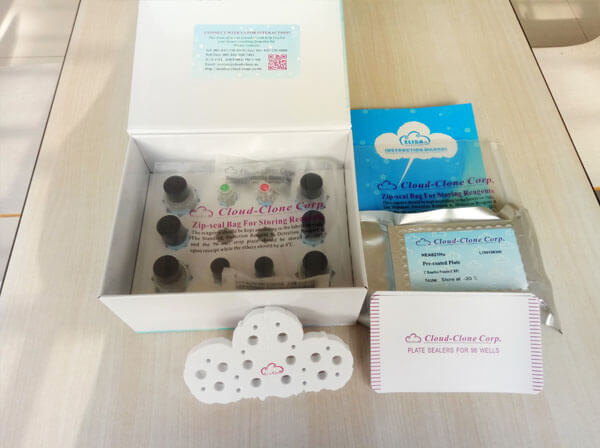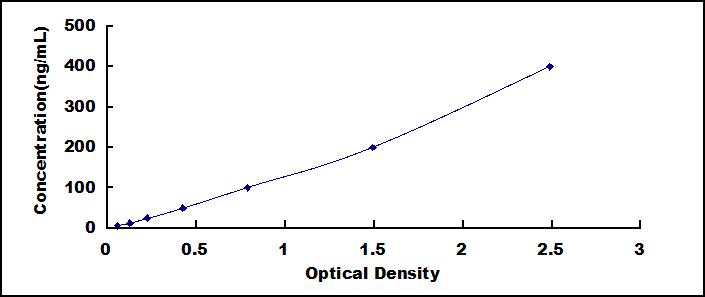Wide-range ELISA Kit for Endostatin (ES) 

- UOM
- FOB US$ 439.00 US$ 627.00 US$ 2,822.00 US$ 5,330.00 US$ 43,890.00
- Quantity
Overview
Properties
- Product No.WEA542Hu
- Organism SpeciesHomo sapiens (Human) Same name, Different species.
- ApplicationsEnzyme-linked immunosorbent assay for Antigen Detection.
Research use only - DownloadInstruction Manual
- CategoryTumor immunityCardiovascular biology
Sign into your account
Share a new citation as an author
Upload your experimental result
Review

Contact us
Please fill in the blank.
Recovery
Matrices listed below were spiked with certain level of recombinant Wide-range Endostatin (ES) and the recovery rates were calculated by comparing the measured value to the expected amount of Wide-range Endostatin (ES) in samples.
| Matrix | Recovery range (%) | Average(%) |
| serum(n=5) | 82-102 | 88 |
| EDTA plasma(n=5) | 96-103 | 101 |
| heparin plasma(n=5) | 80-97 | 84 |
Precision
Intra-assay Precision (Precision within an assay): 3 samples with low, middle and high level Wide-range Endostatin (ES) were tested 20 times on one plate, respectively.
Inter-assay Precision (Precision between assays): 3 samples with low, middle and high level Wide-range Endostatin (ES) were tested on 3 different plates, 8 replicates in each plate.
CV(%) = SD/meanX100
Intra-Assay: CV<10%
Inter-Assay: CV<12%
Linearity
The linearity of the kit was assayed by testing samples spiked with appropriate concentration of Wide-range Endostatin (ES) and their serial dilutions. The results were demonstrated by the percentage of calculated concentration to the expected.
| Sample | 1:2 | 1:4 | 1:8 | 1:16 |
| serum(n=5) | 96-105% | 94-101% | 97-104% | 81-98% |
| EDTA plasma(n=5) | 82-97% | 89-98% | 97-105% | 80-98% |
| heparin plasma(n=5) | 88-105% | 86-94% | 96-105% | 95-105% |
Stability
The stability of kit is determined by the loss rate of activity. The loss rate of this kit is less than 5% within the expiration date under appropriate storage condition.
To minimize extra influence on the performance, operation procedures and lab conditions, especially room temperature, air humidity, incubator temperature should be strictly controlled. It is also strongly suggested that the whole assay is performed by the same operator from the beginning to the end.
Reagents and materials provided
| Reagents | Quantity | Reagents | Quantity |
| Pre-coated, ready to use 96-well strip plate | 1 | Plate sealer for 96 wells | 4 |
| Standard | 2 | Standard Diluent | 1×20mL |
| Detection Reagent A | 1×120µL | Assay Diluent A | 1×12mL |
| Detection Reagent B | 1×120µL | Assay Diluent B | 1×12mL |
| TMB Substrate | 1×9mL | Stop Solution | 1×6mL |
| Wash Buffer (30 × concentrate) | 1×20mL | Instruction manual | 1 |
Assay procedure summary
1. Prepare all reagents, samples and standards;
2. Add 100µL standard or sample to each well. Incubate 1 hours at 37°C;
3. Aspirate and add 100µL prepared Detection Reagent A. Incubate 1 hour at 37°C;
4. Aspirate and wash 3 times;
5. Add 100µL prepared Detection Reagent B. Incubate 30 minutes at 37°C;
6. Aspirate and wash 5 times;
7. Add 90µL Substrate Solution. Incubate 10-20 minutes at 37°C;
8. Add 50µL Stop Solution. Read at 450nm immediately.

Test principle
The test principle applied in this kit is Sandwich enzyme immunoassay. The microtiter plate provided in this kit has been pre-coated with an antibody specific to Wide-range Endostatin (ES). Standards or samples are then added to the appropriate microtiter plate wells with a biotin-conjugated antibody specific to Wide-range Endostatin (ES). Next, Avidin conjugated to Horseradish Peroxidase (HRP) is added to each microplate well and incubated. After TMB substrate solution is added, only those wells that contain Wide-range Endostatin (ES), biotin-conjugated antibody and enzyme-conjugated Avidin will exhibit a change in color. The enzyme-substrate reaction is terminated by the addition of sulphuric acid solution and the color change is measured spectrophotometrically at a wavelength of 450nm ± 10nm. The concentration of Wide-range Endostatin (ES) in the samples is then determined by comparing the O.D. of the samples to the standard curve.
Giveaways
Increment services
Citations
- Endostatin gene therapy enhances the efficacy of IL-2 in suppressing metastatic renal cell carcinoma in miceSpringerLink: u38777121t6660l5
- Erythrocyte Protoporphyrin Fluorescence as a Biomarker for Monitoring Antiangiogenic Cancer TherapySpringerLink: 4v306130302257w0
- Endostatin- and interleukin-2-expressing retroviral bicistronic vector for gene therapy of metastatic renal cell carcinomaWiley: source
- Endostatin neoadjuvant gene therapy extends survival in an orthotopic metastatic mouse model of renal cell carcinomaScienceDirect: S075333221100151X
- Antiangiogenic Activities of Cinnamon, Black and Green Tea Extracts on Experimentally Induced Breast Cancer in RatsScialert: Source
- Inflammation Induced by MMP-9 Enhances Tumor Regression of Experimental Breast CancerPubMed: PMC3619527
- Promotion of adipogenesis by an EP2 receptor agonist via stimulation of angiogenesis in pulmonary emphysemaPubmed:24911647
- Endostatin and kidney fibrosis in aging: a case for antagonistic pleiotropy?Source
- Angiogenesis inhibitor endostatin protects mice with sepsis from multiple organ dysfunction syndromePubMed: 26125086
- Endothelial Dysfunction and Nailfold Videocapillaroscopy Pattern as Predictors of Digital Ulcers in Systemic Sclerosis: a Cohort Study and Review of the LiteraturePubMed: 26142066
- Peripheral vasculopathy in Raynaud phenomenon: Vascular disease biomarkersscience:S1646706X16300052
- Impaired angiogenesis as a feature of digital ulcers in systemic sclerosisPubmed:26920752
- Blood biomarker for early blood brain barrier disruption in ischemic strokepatent:US20170199205A1










